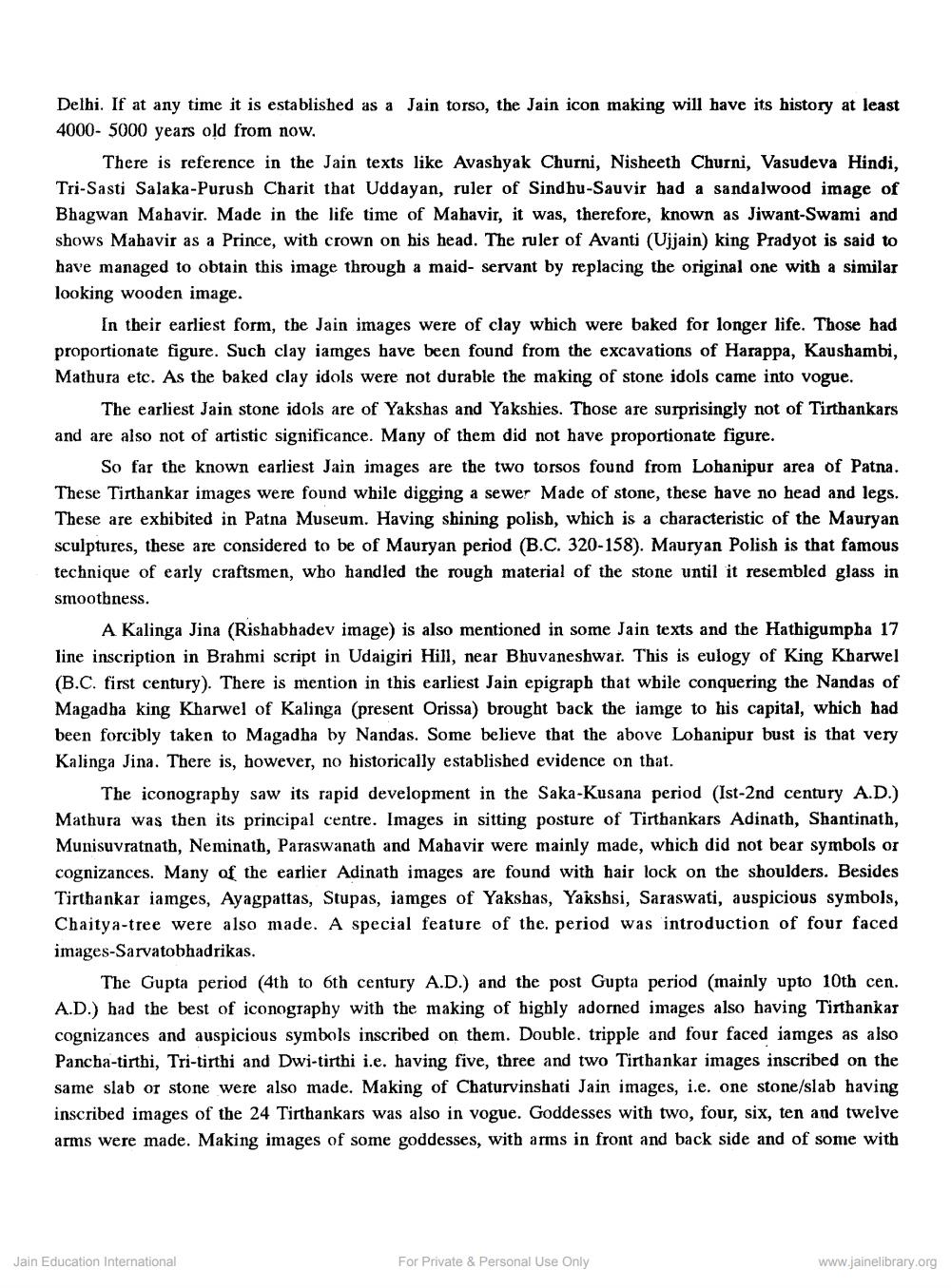________________
Delhi. If at any time it is established as a Jain torso, the Jain icon making will have its history at least 4000-5000 years old from now.
There is reference in the Jain texts like Avashyak Churni, Nisheeth Churni, Vasudeva Hindi, Tri-Sasti Salaka-Purush Charit that Uddayan, ruler of Sindhu-Sauvir had a sandalwood image of Bhagwan Mahavir. Made in the life time of Mahavir, it was, therefore, known as Jiwant-Swami and shows Mahavir as a Prince, with crown on his head. The ruler of Avanti (Ujjain) king Pradyot is said to have managed to obtain this image through a maid- servant by replacing the original one with a similar looking wooden image.
In their earliest form, the Jain images were of clay which were baked for longer life. Those had proportionate figure. Such clay iamges have been found from the excavations of Harappa, Kaushambi, Mathura etc. As the baked clay idols were not durable the making of stone idols came into vogue.
The earliest Jain stone idols are of Yakshas and Yakshies. Those are surprisingly not of Tirthankars and are also not of artistic significance. Many of them did not have proportionate figure.
So far the known earliest Jain images are the two torsos found from Lohanipur area of Patna. These Tirthankar images were found while digging a sewer Made of stone, these have no head and legs. These are exbibited in Patna Museum. Having shining polish, which is a characteristic of the Mauryan sculptures, these are considered to be of Mauryan period (B.C. 320-158). Mauryan Polish is that famous technique of early craftsmen, who handled the rough material of the stone until it resembled glass in smoothness.
A Kalinga Jina (Rishabhadev image) is also mentioned in some Jain texts and the Hathigumpba 17 line inscription in Brahmi script in Udaigiri Hill, near Bhuvaneshwar. This is eulogy of King Kharwel (B.C. first century). There is mention in this earliest Jain epigraph that wbile conquering the Nandas of Magadha king Kharwel of Kalinga (present Orissa) brought back the iamge to his capital, which had been forcibly taken to Magadha by Nandas. Some believe that the above Lohanipur bust is that very Kalinga Jina. There is, however, no historically established evidence on that.
The iconography saw its rapid development in the Saka-Kusana period (Ist-2nd century A.D.) Mathura was then its principal centre. Images in sitting posture of Tirthankars Adinath, Shantinath, Munisuvratnath, Neminath, Paraswanath and Mahavir were mainly made, which did not bear symbols or cognizances. Many of the earlier Adinath images are found with hair lock on the shoulders. Besides Tirthankar iamges, Ayagpattas, Stupas, iamges of Yakshas, Yakshsi, Saraswati, auspicious symbols, Chaitya-tree were also made. A special feature of the period was introduction of four faced images-Sarvatobhadrikas.
The Gupta period (4th to 6th century A.D.) and the post Gupta period (mainly upto 10th cen. A.D.) had the best of iconography with the making of highly adorned images also having Tinthankar cognizances and auspicious symbols inscribed on them. Double. tripple and four faced iamges as also Pancha-tirtbi, Tri-tirthi and Dwi-tirthi i.e. having five, three and two Tirthankar images inscribed on the same slab or stone were also made. Making of Chaturvinshati Jain images, i.e. one stone/slab having inscribed images of the 24 Tirthankars was also in vogue. Goddesses with two, four, six, ten and twelve arms were made. Making images of some goddesses, with arms in front and back side and of some with
Jain Education International
For Private & Personal Use Only
www.jainelibrary.org




